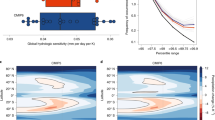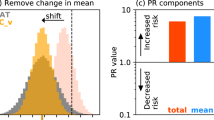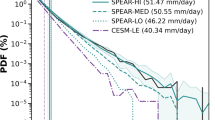Abstract
Changes in precipitation extremes under greenhouse warming are commonly assumed to be constrained by changes in the amounts of precipitable water in the atmosphere1,2,3,4. Global climate models generally predict only marginal changes in relative humidity5, implying that the actual amount of atmospheric precipitable water scales with the water vapour content of saturation, which is governed by the Clausius–Clapeyron relation. Indeed, changes in daily precipitation extremes in global climate models seem to be consistent with the 7% increase per degree of warming given by the Clausius–Clapeyron relation3,4, but it is uncertain how general this scaling behaviour is across timescales. Here, we analyse a 99-year record of hourly precipitation observations from De Bilt, the Netherlands, and find that one-hour precipitation extremes increase twice as fast with rising temperatures as expected from the Clausius–Clapeyron relation when daily mean temperatures exceed 12 ∘C. In addition, simulations with a high-resolution regional climate model show that one-hour precipitation extremes increase at a rate close to 14% per degree of warming in large parts of Europe. Our results demonstrate that changes in short-duration precipitation extremes may well exceed expectations from the Clausius–Clapeyron relation. These short-duration extreme events can have significant impacts, such as local flooding, erosion and water damage.
This is a preview of subscription content, access via your institution
Access options
Subscribe to this journal
Receive 12 print issues and online access
$259.00 per year
only $21.58 per issue
Buy this article
- Purchase on Springer Link
- Instant access to full article PDF
Prices may be subject to local taxes which are calculated during checkout


Similar content being viewed by others
References
Trenberth, K. E., Dai, A., Rasmussen, R. & Parsons, D. The changing character of precipitation. Bull. Am. Meteorol. Soc. 84, 1205–1217 (2003).
Hegerl, G. et al. Climate Change 2007: The Physical Science Basis. Contribution of Working Group I to the Fourth Assessment Report of the Intergovernmental Panel on Climate 664–745 (Cambridge Univ. Press, Cambridge, 2007).
Pall, P., Allen, M. & Stone, D. Testing the Clausius–Clapeyron constraint on changes in extreme precipitation under CO2 warming. Clim. Dyn. 28, 351–363 (2007).
Allen, M. R. & Ingram, W. J. Constraints on the future changes in climate and the hydrological cycle. Nature 419, 224–232 (2002).
Bony, S. et al. How well do we understand and evaluate climate change feedback processes? J. Clim. 19, 3445–3482 (2006).
Semenov, V. & Bengtsson, L. Secular trends in daily precipitation characteristics: Greenhouse gas simulation with a coupled AOGCM. Clim. Dyn. 19, 123–140 (2002).
Frei, C., Schöll, R., Fukutome, S., Schmidli, J. & Vidale, P. Future change of precipitation extremes in Europe: Intercomparison of scenarios from regional climate models. J. Geophys. Res. 111, D06105 (2006).
Emori, S. & Brown, S. Dynamic and thermodynamic change in mean and extreme precipitation under climate change. Geophys. Res. Lett. 32, L17706 (2005).
van Ulden, A. P. & van Oldenborgh, G. Large-scale atmospheric circulation biases in global climate model simulations and their importance for climate change in central Europe. Atmos. Chem. Phys. 6, 863–881 (2006).
Trapp, R. J. et al. Changes in severe thunderstorm environment frequency during the 21st century caused by anthropogenically enhanced global radiative forcing. Proc. Natl Acad. Sci. 104, 19719–19723 (2007).
Baker, M. B. & Peter, T. Small-scale cloud processes and climate. Nature 451, 299–300 (2008).
Trenberth, K. E. Atmospheric moisture recycling: Role of advection and local evaporation. J. Clim. 12, 1368–1381 (1999).
Ingram, W. J. On the robustness of the water vapor feedback: GCM vertical resolution and formulation. J. Clim. 15, 1917–1921 (2002).
Held, I. M. & Soden, B. J. Robust responses of the hydrological cycle to global warming. J. Clim. 19, 5686–5699 (2006).
Guichard, F. et al. Modelling the diurnal cycle of deep precipitating convection over land with cloud-resolving models and single-column models. Q. J. R. Meteorol. Soc. 130, 3139–3172 (2004).
Lenderink, G., van den Hurk, B., van Meijgaard, E., van Ulden, A. & Cuijpers, H. Simulation of present-day climate in RACMO2: First results and model developments. Tech. Rep. TR-252 (Royal Netherlands Meteorological Institute, De Bilt, 2003).
Lenderink, G., van Meijgaard, E. & Selten, F. Intense coastal rainfall in the Netherlands in response to high sea water temperatures: Analysis of the event of august 2006 from the perspective of a changing climate. Clim. Dyn. (2008, in the press).
Lenderink, G., van Ulden, A., van den Hurk, B. & Keller, F. A study on combining global and regional climate model results for generating climate scenarios of temperature and precipitation for the Netherlands. Clim. Dyn. 29, 157–176 (2007).
Schneider, T. & O’Gorman, P. A. Proc. Hawaiian Aha Huliko’a Winter Workshop 61–66 (University of Hawaii, Honolulu, 2007).
<http://www.knmi.nl/klimatologie/onderzoeksgegevens/index.html>.
Uppala, S. et al. The ERA-40 re-analysis. Q. J. R. Meteorol. Soc. 131, 2961–3012 (2005).
Hewitt, C. & Griggs, D. Ensembles-based predictions of climate changes and their impacts (ENSEMBLES). Eos 85, 566 (2004).
Acknowledgements
Financial support by the EU FP6 Integrated Project ENSEMBLES (Contract number 505539) and the Dutch Climate Change and Spatial Planning program (BSIK) is gratefully acknowledged. We thank G. J. v. Oldenborgh, F. Selten, R. Haarsma, A. v. Ulden and R. Boers for comments on earlier drafts of this paper. This work is partly motivated by earlier unpublished work on precipitation temperature relations by A. Klein Tank and G. Können.
Author information
Authors and Affiliations
Contributions
The main idea and most analyses were by G.L and E.v.M. carried out the regional climate simulations and contributed to the text.
Corresponding author
Supplementary information
Supplementary Information
Supplementary figures S1-S7 and table S1 (PDF 1614 kb)
Rights and permissions
About this article
Cite this article
Lenderink, G., van Meijgaard, E. Increase in hourly precipitation extremes beyond expectations from temperature changes. Nature Geosci 1, 511–514 (2008). https://doi.org/10.1038/ngeo262
Received:
Accepted:
Published:
Issue Date:
DOI: https://doi.org/10.1038/ngeo262
This article is cited by
-
Historical regional climate changes in Japan in winter as assessed by a 5-km regional climate model with a land surface process
Progress in Earth and Planetary Science (2023)
-
Thermodynamically enhanced precipitation extremes due to counterbalancing influences of anthropogenic greenhouse gases and aerosols
Nature Water (2023)
-
Positive correlation between wet-day frequency and intensity linked to universal precipitation drivers
Nature Geoscience (2023)
-
Anthropogenic influence on extremes and risk hotspots
Scientific Reports (2023)
-
Large anomalies in future extreme precipitation sensitivity driven by atmospheric dynamics
Nature Communications (2023)



